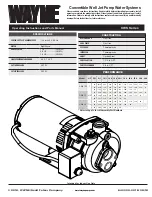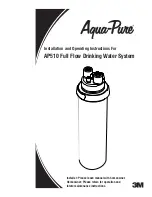
6
5. Grades B, C, D, E, F, G - Discard old elements and o-rings.
6. Clean inlet manifold with a mild
detergent using a long-handled
brush or clean rag attached to a
rod. Manifold must be free of
all dirt and grease to insure
proper o-ring seal between
new filter element top cap
and inlet manifold.
7. Install new o-rings in the
o-ring grooves in each filter
element.
8. Starting from the outside
(filter element closest to the
vessel wall), screw new filter
elements into inlet manifold
connections. A cone in the
manifold will guide the
element bolt into the female
threads.
NOTE: Grades E, F and G - Do not handle elements by outside
foam cover. Handle by plastic packaging and bottom end
cap only.
NOTE: It is only necessary to finger tighten the filter
element to insure a seal.
DO NOT WRENCH TIGHTEN
9. Close vessel
9A. Model 32 - Reassemble bottom shell, o-ring and seal-
ring retainer to housing. Make sure seal-ring retainer
provides a backup for the o-ring as shown in drawing.
9B. Models with hand hole
a. Reinsert seal plate and seal plate gasket into vessel
and position on lip as shown in drawing.
NOTE: Do not reuse gasket if gasket is torn or gasket surface
is damaged.
b. Reinstall yoke and nut.
c. Tighten nut making sure that gasket is properly
positioned under seal plate.
9C. Models with flanged bottom
a. Swing blind bottom flange into position.
b. Rebolt after inspecting flange gasket to ensure its
integrity.
10. Pressurize unit slowly by slowly opening inlet valve,
then opening outlet valve, and finally closing by-pass
valve.
3.0 Maintenance
A. When to Replace Filter Element
NOTE: Grades B, C, D, E, F, G - complete element is replaced:
1. Grades D (dry desiccant afterfilter)
Initial drop: 1 psi (0.07 kgf/cm
2
). Pressure drop increases
as element loads with solid particles. Replace when
pressure drop reaches 10 psi (0.7 kgf/cm
2
) (indicator in
red area) or annually, whichever occurs first.
2. Grade A (mechanical separator)
Element should not require replacement unless physically
damaged. If sludge accumulates, element can be
removed and cleaned with soap and water.
3. Grades B, C, E, F (coalescing filters)
a. Initial (dry) pressure drop: 1 psi (0.07 kgf/cm
2
) to 2 psi
(0.14 kgf/cm
2
)
b. Operating pressure drop: As filter becomes liquid
loaded (wetted), pressure drop will increase to 2 to
6 psi (0.14 to 0.42 kgf/cm
2
). Further pressure drop
occurs as element loads with solid particles.
FOR MAXIMUM FILTRATION EFFICIENCY, REPLACE ELEMENT
WHEN PRESSURE DROP REACHES 6 PSI (0.42 KGF/CM
2
)
(INDICATOR IN RED AREA) OR ANNUALLY, WHICHEVER OCCURS
FIRST.
NOTE: Pressure drop may temporarily increase when flow is
resumed after flow stoppage. Pressure drop should return
to normal within one hour.
NOTE: Grades E and F - During normal operation bottom of
foam sleeve will have a band of oil. Spotting above the band
indicates that liquids are accumulating faster than they can
be drained and that prefiltration is required.
4. Grade G (activated carbon filters)
a. Adsorption capacity - 1000 hours at rated capacity.
Element life is exhausted when odor can be detected
downstream of the filter.
B. Procedure for Element Replacement
THIS FILTER IS A PRESSURE CONTAINING
DEVICE. DEPRESSURIZE BEFORE SERVICING.
1. By-pass the filter to permit
servicing.
2. Depressurize the filter assembly
slowly by opening blowdown
valve.
3. Open pressure vessel
3A. Model 32 - Remove flange bolts.
Lower bottom shell, o-ring, and seal
ring retainer.
3B. Models with handhole
a. Remove nut and yoke
b. Lift seal plate and turn so that seal plate and seal
plate gasket can be removed.
3C. Models with flanged bottom
a. Loosen bottom blind flange bolts.
b. Remove all but one bolt.
c. Swing flange to one side.
4.
Starting in the center, unscrew the filter elements
and remove the filter elements and element
o-rings.
Bottom Flange
O-RING
PLASTIC
SEAL RING
RETAINER
LOWER
BOTTOM
OF SHELL
All Grades -
Element Replacement
SEAL PLATE
VESSEL
YOKE
NUT
GASKET
TILT THE SEAL PLATE
AND GASKET TO FIT IN OPENING
HAND HOLE
Handhole
Model 32
CONE
INLET
MANIFOLD
O-RINGs
CARTRIDGE
—


























